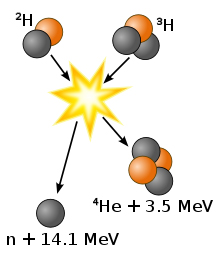The promise of fusion power
David A Gabel, Environmental News Network
It has been called the holy grail of energy technology; a perfectly clean source with an unlimited supply. Nuclear fusion has been demonstrated to be possible, but converting it to a viable energy source remains technically elusive.
However, research on making fusion energy reality is in progress, and there are some who are convinced that there will be a day when this free and abundant source will arrive.
Our current nuclear technology, fission, is the breaking of the atomic nucleus, which releases massive amounts of energy. For a fusion reaction, the nuclei of two atoms fuse together to form a heavier nucleus.
The resulting release of energy is incredibly large. To put it in perspective, fusion is the power of the sun, a force strong enough to heat a planet that is 93 million miles away.
The fuels for a fusion reaction are the hydrogen isotopes, deuterium and tritium, which are abundantly found in seawater. Experts estimate that there is enough deuterium in seawater to last practically forever.
Riccardo Betti, professor at the University of Rochester’s Laboratory for Laser Energetics and a leading expert on nuclear fusion, believes that the deuterium found in one cubic kilometer of seawater is equivalent in terms of energy to the entire world’s oil supply.
Another great advantage of fusion is that it does not produce any harmful byproducts. For example, spent fuel from standard fission plants is highly radioactive, and what to do with it has become a major problem. For fusion, two hydrogen atoms combine to form helium, a harmless noble gas.
A myriad of technical problems keep nuclear fusion just beyond our reach at the moment. Material science has not progressed far enough yet to provide a material that can withstand the rigors of the fusion chamber.
Also lasers, which are used to fire at the deuterium, have to fire accurately at a small deuterium pellet ten times per second, which has proved challenging. Plus, recent experiments at fusion reaction have not produced enough energy to make up for the energy that gets put in.
Scientists like Professor Betti are working on new designs for fusion reactions, hoping that they can come across a viable model for large-scale deployment. For example, inertial confinement fusion is being developed at the Lawrence Livermore National Laboratory in California and aided by the University of Rochester.
The process solidifies the isotopes into pellets, shoots lasers at the pellets, and then pressurizes them to about 500 billion atmospheres (one atmosphere equals standard air pressure at sea level). This ignites the pellet into a fusion reaction.
If fusion becomes a reality, we can all say goodbye to fossil fuels for providing electricity. We can also say goodbye to other renewables like solar and wind.
Fusion offers the promise of unlimited energy without any of the harmful side effects. It would revolutionize our attitudes towards electricity use, and spawn new innovative uses of electricity. It would without a doubt, launch humanity into a new era.
For more information: http://www.rochester.edu/news/show.php?id=3688


























